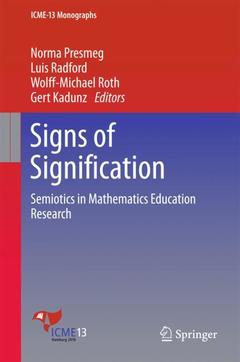Signs of Signification, Softcover reprint of the original 1st ed. 2018 Semiotics in Mathematics Education Research ICME-13 Monographs Series
Coordonnateurs : Presmeg Norma, Radford Luis, Roth Wolff-Michael, Kadunz Gert

This book discusses a significant area of mathematics education research in the last two decades and presents the types of semiotic theories that are employed in mathematics education. Following on the summary of significant issues presented in the Topical Survey, Semiotics in Mathematics Education, this book not only introduces readers to semiotics as the science of signs, but it also elaborates on issues that were highlighted in the Topical Survey. In addition to an introduction and a closing chapter, it presents 17 chapters based on presentations from Topic Study Group 54 at the ICME-13 (13th International Congress on Mathematical Education). The chapters are divided into four major sections, each of which has a distinct focus. After a brief introduction, each section starts with a chapter or chapters of a theoretical nature, followed by others that highlight the significance and usefulness of the relevant theory in empirical research.
Section 1: Sociocultural perspectives on semiosis
Introduction to Section 1: Luis Radford
Chapter 2. Luis Radford: Semiosis and subjectification: The classroom constitution of mathematical objects.
Chapter 3. Wolff-Michael Roth: Birth of signs: A (Spinozist-Marxian) materialist approach.
Chapter 4. Ulises Salinas-Hernandez and Isaias Miranda: Relating computational Cartesian graphs to a real motion: An analysis of high school students’ activity.
Chapter 5. Anna Shvarts: Joint attention in resolving the ambiguity of different presentations: A dual eye-tracking study of the teaching-learning process.
Chapter 6. Debbie Stott: Attention catching: Connecting the space of joint action and togethering.
Section 2: Language and text orientations
Introduction to Section 2: Gert Kadunz
Chapter 7. Gert Kadunz: A matter of translation.
Chapter 8. Candia Morgan: Using social semiotics to explore institutional assumptions about mathematics students and teachers.
Chapter 9. Michael Otte: Semiotics, epistemology, and mathematics.
Chapter 10. Uta Priss: A semiotic-conceptual analysis of conceptual development in learning mathematics.
Section 3: Peircean semiotics, including semiotic chaining and representations
Introduction to Section 3: Norma PresmegChapter 11. Adalira Sáenz-Ludlow: Iconicity and diagrammatic reasoning in meaning-making.
Chapter 12. Jesús Victoria Flores Salazar: Semiotic representations: A study of dynamic figural register.
Chapter 13. Barbara Kinach: Progressive visualization tasks and semiotic chaining for mathematics teacher preparation: Towards a conceptual framework.
Chapter 14. Corin Mathews, Hamsa Venkat, and Mike Askew: Primary teachers’ semiotics praxis: Windows into the handling of division tasks.
Section 4: Semiotic resources including gesturing and tools
Introduction to Section 4: Michael Roth
Chapter 15. Yasmine Abtahi: Gradual change of perception: Signs, tools, and meaning-making of fractions.
Chapter 16. Christina Krause and Alexander Salle: On the role of gestures for the descriptive analysis of ‘Grundvorstellungen’: A case of linear functions.
Chapter 17. Petra Menz and Nathalie Sinclair: Diagramming and gesturing during mathematizing: Kinesthetic and haptic interactions support mathematical ideation.
Chapter 18. Osama Swidan and Naomi Prusak: Objectifying the inclusion relationship of quadrilaterals in a synchronic-interactive and collaborative computer supported environment.
Chapter 19. Discussion and conclusions. The editors.
Discusses a significant area of mathematics education research in the last two decades
Highlights the types of semiotic theory that are employed in mathematics education
Shows how these theories are being used in empirical research
Date de parution : 01-2018
Ouvrage de 372 p.
15.5x23.5 cm
Disponible chez l'éditeur (délai d'approvisionnement : 15 jours).
Prix indicatif 168,79 €
Ajouter au panierDate de parution : 06-2019
Ouvrage de 372 p.
15.5x23.5 cm
Disponible chez l'éditeur (délai d'approvisionnement : 15 jours).
Prix indicatif 121,31 €
Ajouter au panier


